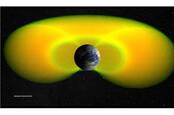This article is more than 1 year old
Bombing raids during WWII sent out shockwaves powerful enough to alter the Earth's ionosphere
Impact power sent electrons shooting off into space
The volume of bombs dropped by the Allied Forces in the Second World War were powerful enough to send shockwaves that rippled throughout the skies, weakening the Earth’s ionosphere.
Earth’s ionosphere extends about 1,000 kilometers (about 621 miles) above its surface and is made up of a shell of ions and electrons that reflect radio waves. Regular measurements have been taken to keep track of the concentration of these particles over time by scientists around the world.
A historian and a meteorologist from the University of Reading in the UK decided to dig through old records taken during 1943 to 1945 at the Radio Research Station near Slough, England. They correlated that data with the time and dates of major bombing raids across cities in France and Germany during the Second World War.
They found that after these raids, the ionosphere’s critical frequency dipped. It’s a measurement of the frequency of the reflected radio waves and a decrease is a sign that the number of electrons in the ionosphere has dropped.
It is believed that the shockwaves sent ripples of energy that heated the ionosphere, giving the electrons a kick of kinetic energy to escape. The results have been published in the Annales Geophysicae.
“It is astonishing to see how the ripples caused by man-made explosions can affect the edge of space. Each raid released the energy of at least 300 lightning strikes. The sheer power involved has allowed us to quantify how events on the Earth’s surface can also affect the ionosphere,” said Chris Scott, co-author of the paper and a professor of space and atmospheric physics.
Solar flares or simple explosives?
The ionosphere is also affected by solar radiation. Powerful blasts from solar flares can disturb high frequency communication frequencies from 3MHz to 30MHz, causing temporary blackouts to affect GPS systems, radio telescopes and some early warning radar.
The researchers made sure to only investigate the most powerful bombing raid events to make sure it wasn’t just solar radiation that was fudging the numbers.
The bombs carried by the Allied Forces’ planes were four times heavier than the ones carried by Germany’s Luftwaffe. One in particular, the Grand Slam bomb carried by the RAF, was a whopping 10,000 kilograms, and was nicknamed the “Ten Ton Tess.”
“Aircrew involved in the raids reported having their aircraft damaged by the bomb shockwaves, despite being above the recommended height,” said Patrick Major, co-author of the paper and a history professor. "Residents under the bombs would routinely recall being thrown through the air by the pressure waves of air mines exploding, and window casements and doors would be blown off their hinges."
“There were even rumours that wrapping wet towels around the face might save those in shelters from having their lungs collapsed by blast waves, which would leave victims otherwise externally untouched.”
The duo aren’t sure how radio communications were impacted during these raids. They hope that the public will help them digitise old data to help them work out the minimum explosive energy needed to dent the ionosphere.
“The images of neighbourhoods across Europe reduced to rubble due to wartime air raids are a lasting reminder of the destruction that can be caused by man-made explosions. But the impact of these bombs way up in the Earth’s atmosphere has never been realised until now,” Scott said. ®

